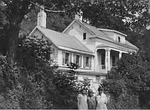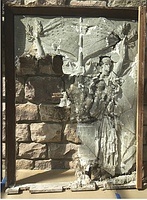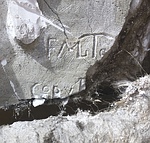A Discovery in the Captain John House
In the spring of 2018, I was tasked with overseeing the restoration and rehabilitation of the Captain John House, an old and valued member of the Snedens Landing community in Palisades, New York. In 1916, Mary Lawrence Tonetti inherited the Captain John House along with most of the other houses that her mother had accumulated in the Landing over the years. Besides making these houses available–at very affordable rents–to an ever-changing cast of characters belonging to her vibrant New York City arts circle, Mary was a compulsive builder who loved adding amenities to her various properties. In the 1920s, she bestowed upon the Captain John House a stone “Ballroom.”
When stripping the interior of the “Ballroom,” we found that one of the partitions had started its life as a room divider comprised of six framed plaster reliefs. These panels were crudely nailed together and brutally chopped off where fitting was required. On one side of a hallway there were four panels arranged two over two. On the other side, two panels were lain in sideways for a better fit. Over the years, several subsequent layers of finish had been applied to both sides of these fragile plaster reliefs. Plaster lath had been nailed directly to the frames with the high points of the reliefs chopped off so as to not interfere with the lath. Electrical wiring was run right through them. Even doors had been cut through them. I was flabbergasted.
I believed these were artist proofs of a memorial that was most likely to be cast in bronze. I scoured the internet looking for pictures of the completed plaque with no luck. Who was the mystery artist? Had the artist been housed in the Captain John? None of the names on the plaque were recognized as being local. There were no identifying Troop or Squadron numbers represented. I asked Alice Gerard, author of Historic Houses of Palisades New York, if she could help me track down the artist.
Alice’s first instinct was that the plaque was probably the work of Mary Tonetti’s husband, François. She told me that after François Tonetti died, Mary very unceremoniously disposed of most of the work in his studio by digging a big hole somewhere along Lawrence Lane and burying all of it. Mary apparently did not want to remember her husband through his great works.
I just couldn’t imagine Mary having these beautiful things nailed together and chopped up the way they were. However, on close inspection, down in one shattered corner, there was François’s signature.
In Isabelle Savell’s book, The Tonetti Years at Snedens Landing, there is a list of Francois’ sculptures. One of his last was a World War I memorial plaque commissioned by Best and Co., listed as whereabouts/unknown. Just recently, a friend discovered an article in the July 10, 1920 issue of The Dry Goods Economist that announces Best & Co.’s unveiling of François Tonetti’s last work.
We’re not quite sure just what to do with our discovery. For now, we’ll just keep it safe. And, please, if anyone knows of any other old photos of this house, particularly of the “Beer Hall” era, I would very much like to see them. As they say, a picture is worth a thousand words.





